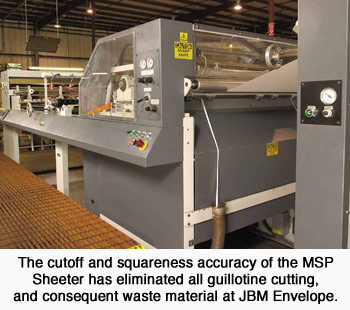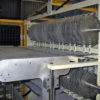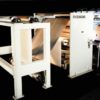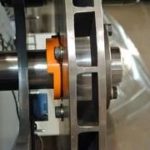After brokering envelopes for a number of years, JBM President, Greg Sheanshang ventured into envelope manufacturing. Starting small, the company was located in a 6,000 square foot space in Cincinnati, OH. Growth soon demanded more space and the company built a new 30,000 square foot facility in an industrial park in Lebanon, OH. With more space, Sheanshang set new goals to improve production flow and evaluate machinery and equipment to handle the ever-growing business volume. The new business spawned by these procedures and evaluations necessitated yet another expansion in 1996 to 61,000 square feet.
In 1989, JBM determined that purchasing a sheeter would provide much needed flexibility by converting inventory in their own facility, at their own pace rather than waiting for an outside converter’s schedule. “Back in the beginning, we needed tiny sheets,” said Sheanshang. “JBM relied on a ‘friendly’ competitor to slit and cut rolls we purchased from mills. We were also purchasing sheeted stock from mills, which was quite expensive. It was at this point that we considered the purchase of a sheeter.” Shopping the used converting equipment market yielded a sixties vintage sheeter which needed extensive refurbishing. “We bought it, but if we had to do it over again, considering the amount of money we poured into that machine, we could have bought new. Sheeting in-house did slash the up-charges associated with having converting done outside,” Sheanshang continued, “but the accuracy wasn’t there and we needed to guillotine trim everything, resulting in loss of revenue in waste.”
In the right direction
Despite the shortcomings of the used sheeter and the disappointment that it wasn’t delivering all the benefits in-house sheeting usually provides, JBM knew they were heading in the right direction. Investing in a new sheeter was the answer and they commenced a search for appropriate sheeters for their application. “We looked at the entire marketplace but there were a number of reasons we settled on the Maxson MSP Sheeter,” Sheanshang remarked, “A primary consideration was sourcing reliable, American-made equipment that we were sure would be supported with nearby technical assistance and quick delivery of spare parts.” The MSP Sheeter also satisfied JBM’s requirement for speed and precision with a machine capable of running at speeds up to 1000 fpm with sheet length accuracy of ±0.015 inches.
The Maxson MSP Sheeter was purchased and the installation was completed in December 1999. “We were well supported by Maxson Automatic’s installation and training staff,” explained Dana Fox, JBM’s Director of Operations.

“We have realized all kinds of pluses as a result of purchasing the MSP Sheeter,” Fox went on to say. “The first thing that became apparent was that the footprint of the MSP Sheeter was so much smaller than the old, used sheeter. We picked up quite a bit of floor space that is now being used for other purposes that are contributing to increased production.”
The Maxson sheeter brought a new efficiency to JBM’s use of personnel. After one month of training a single sheeter operator was running the machine by himself with excellent results. That single operator can also make size changes by entering instructions by keypad that controls the microprocessor. Operators previously assigned to the used machine are now occupied elsewhere in the production stream – another savings.
Condensed converting
“We also see huge savings in overhead since the MSP Sheeter’s speed is condensing our converting production time from three shifts over seven days to two shifts over five days,” concludes Fox. “Because the sheeter’s cut is so precise, there is no more need for guillotine trimming at all. We put those operators to work on other tasks, too. We sold the guillotine equipment and are seeing substantial savings in waste conservation. We used send a truckload of waste away every other day.”
Ninety-eight percent of JBM’s material comes in roll stock form from mills or paper merchants on a just-in-time basis. Since the MSP Sheeter is ideal for short runs, they save money by not having huge inventories eating up space in their warehouse and can accept orders of all sizes. “We have calculated that the MSP Sheeter will pay for itself in one year,” summarized Fox. “So many enhancements and benefits of this sheeter are being reflected in the bottom line.”
JBM Envelope’s MSP Sheeter is equipped with two air-shafted roll stands, capable of handling rolls up to 60″ in diameter and weighing as much as 5,000 pounds. “At this point, we are sheeting two rolls of either 24# white woven or 24# kraft paper. However, we are contemplating an additional roll stand which will increase our production by one-third,” Fox reported.
The MSP is equipped with two air-shafted roll stands capable of handling rolls up to 60 in. in diameter and weighing as much as 5,000 lbs.
Maxson’s breaker roll design web conditioning system ensures smooth passage of the web to the cutter section which is equipped with 4 pairs of easily adjusted slitters. Typically, JBM Envelope sheets one, two and three piles, and ease of adjustment and convenient accessibility becomes especially critical for swift setup changes and short runs. The cutter is also equipped with a trim removal system and a chevroned air loaded squeeze roll that acts to prevent wrinkles in the web prior to entering the knife section. Accuracy is controlled at this point by the dual motor drive system governed by a microprocessor that is constantly reading digital signals from the draw drum and the knife revolver servomotors during each revolution.
After exiting the cutting section, the sheeted material enters the patented Maxson Airfoil Overlap System where sheets are overlapped, or shingled, as they pass through the tape section and are conveyed on to the stacker. It is this process that substantially increases overall speed.
The MSP Sheeter is equipped with a cantilevered stacker and JBM opted for a 61″ pile option. As the cut packets pass to the stacker table, they are jogged into perfect, ice block piles.
It’s hip to be square
“Squareness and sheet length cutoff are so precise, we send sheeted product directly to the litho department for printing,” observed Fox. This was never possible before. The proof of cut accuracy shows once the printing is completed and the stacks go to the die cutter. If squareness is not maintained in the sheeting operation, any lines printed on the piece will be crooked. “We are always amazed that the sheeter turns out a consistently perfect product,” summarized Fox. “A production cycle, from time of order until delivery, used to be 15-17 days – now it is 10-12 days. We have just started our express service of 7 days on coins and drive-in envelopes.”
With the aid of their state-of-the-art graphics department, JBM assists customers with design work and pre-press. In-house litho presses produce one to four color work with over-production and more specialized printing going outside. The cut is so clean and dust free, they send sheeted stock to printers with total confidence that squareness will result in perfect registration and the product will be completely free of dust particulate which causes hickies during printing.
“Maintenance of the MSP has proved to be so simple, a knife change can take less than four hours. That compares to being off-line for two shifts with our old sheeter,” asserts Fox. “There are dollars saved in countless ways because of this sheeter.”
“We couldn’t be more pleased with the results that have come from installing the MSP Sheeter,” summarized Fox. “We only wish we had done it years ago.”
Reprinted from Converting Magazine, February 2001






